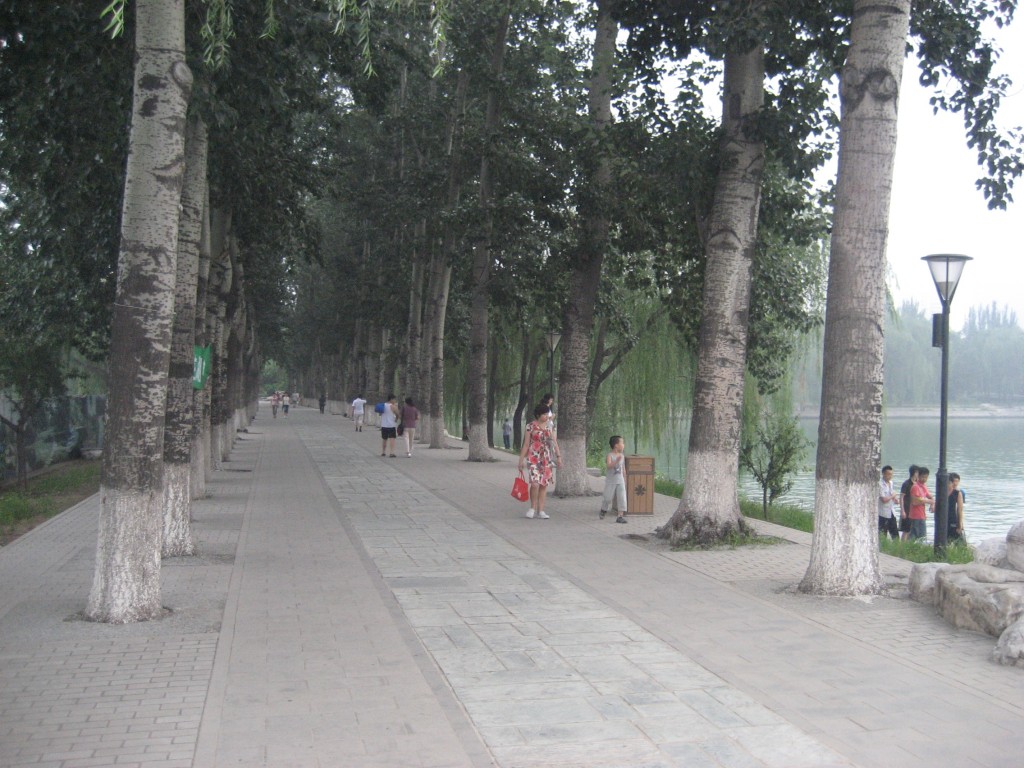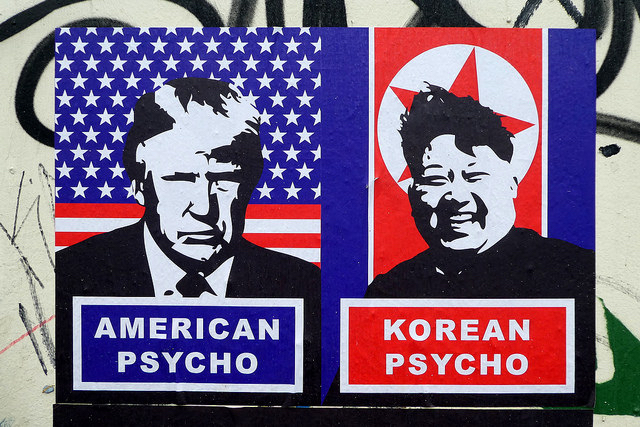The north entrance to Yuyuantan Park in Beijing’s Haidian district is not the main entrance. After passing through a working-class neighborhood of three and five-story brick apartment buildings, this entrance is at the bottom of a sloping street lined with fruit-sellers and hawkers. On one side of the street, an old neighborhood is being demolished; on the other side, new apartment buildings have arisen. These buildings are handsome, understated, some of the most expensive in Beijing, and the residence of the new neoliberal elite.
Evening strollers using Yuyuantan’s north entrance are poor or middle-class. Families pass by on pedal trikes with children in the back. Old men walk in the humid summer heat with their shirts tied around their chest. Couples and families go for a walk after dinner. Teenagers are out for the evening, mostly in tight all-boy or all-girl clusters. Most visitors have cheap season passes; those without a pass pay a small 2 RMB admission fee.
There is a sense of placidity once through the gate and inside the park’s greenery. A group of speed-walkers passes along, but at this hour strenuous exercise is the exception. Most walkers are soaking in the sense of calm that the park lakes provide in the midst of urban noise and rush. The city has grown up around Jade Lake Park, to use its English name, surrounding an area that has been a pleasant retreat for centuries. Only a half-century ago was it organized as a public park. Until relatively recently, the Haidian district had substantial agriculture; a few truck farms are all that is left. Today Yuyuantan has become a green island bordered at its west by the intense traffic of Ring Road 3.
There is a sense of solicitude in China’s urban parks, a social agreement to respect different forms of human diversion so long as they are not unruly intrusions. Public music is ubiquitous, sometimes social and sometimes private. Once alongside the Huanhua stream at the park surrounding Du Fu’s thatched cottage in Chengdu, I watched an older, gray-haired couple stand amid the bamboo to practice singing a duet. She interrupted to correct him gently and they re-started their tune together. They created their own privacy in a public space. This evening in Yuyuantan a folk-song four-some of three women singers and a male accordionist is just finishing its public practice session due to the gathering darkness. They can no longer see their music sheets.
The lake grows softer as its colors begin to fade. We walk down an esplanade of white poplars that separates two lakes. People sit quietly gazing across the water or walk in pairs or small groups, speaking softly. A few lovers sit by the shore, behaving modestly. In one stretch, swimmers are in the shallow waters of the western lake escaping the heat. The eastern lake has been drained during the construction of a new subway line beneath its bed.
This park is the product of generations of earth-moving, shaping, and planting. There has been landscaping done here for nearly a thousand years since the Jin Dynasty when the Yongding River first was diverted to create these lakes as an imperial court pleasure-ground and high-class fishing camp. The only architectural remnant from those days, at the far eastern end of the lakes, is the Diaoyutai state guesthouse, which recently hosted Henry Kissinger for 40th anniversary celebrations of the China-US detente meetings begun there in 1971. A different sort of earth-shaping takes place at state meetings held at that edge of the park.
Overhead as we walk, swooping and diving bats are out to catch the insects that proliferate along the lake shores. Under a lake-side willow tree in the growing dusk, a 50-ish woman with a strong and good voice sings an old popular song, Zai Na Yao Yuan De Di Fang (‘In a Distant Place’). She sits alone and sings:
In a distant place, there is a good girl –
Whenever people pass by her yurt, they look back at her.
Her reddish face is like the red sun.
Her lovely and moving eyes are like the bright moon at night.
I would love to abandon my properties to herd sheep with her…
There is a strange resonance to a romantic invocation of pastoralism and a wish to abandon property in sight of large red commercial neon signs mounted atop nearby buildings. Beyond the lake’s western end rises the needle spire of China Central Television’s broadcasting tower, the tallest structure in Beijing. To sing such a song while facing that tower, an architectural emblem of contemporary China, seems both anti-modernist and an act of solace. The lake amplifies the woman’s voice and her song carries hundreds of meters. As we walk on, a man’s voice rolls faintly off a hillside with another song.
Yuyuantan Park testifies to Beijing’s environmental imbalances, problems especially aggravated by the city’s 20-plus million population. The stresses of crowding and pollution demand an outlet; a large patch of cultivated greenery and water can only begin to alleviate those stresses. As a large, heavily-used urban park, Yuyuantan encompasses a tension between sociality and nature. To walk on a weekday evening after work means navigating between hundreds and thousands more people seeking similar release. It means relinquishing some degree of sociality in order to gain a better sense of peace from the surrounding water, trees and plantings.
In the midst of a crowd there is no escaping the crowd. The beauty of a long lane of white poplars leading toward a small temple structure on a low hill also frames hundreds of pedestrians on the stone walkway ahead. Any concept of individuality fades more quickly than the sunset. The park, in all its designed artifice, excludes individualism while offering a simulacrum of nature. There is no shi wai tao yuan – a phrase from the classic writer Tao Yuanming meaning an ideal paradise – to which weary citizens can retreat.
While Yuyuantan offers tens of thousands of visitors daily a simulation of nature as a means of release, it does so within the social construction of anti-political space. Any overt manifestation of politics instead of folk music, dance, or exercise would be ended near immediately. Here freedom to recreate does not include freedom to associate or speak publicly. For example, in the late 1990s a group of Guo Lin qigong practitioners who met to exercise in Yuyuantan as an anti-cancer survivors group fell under heavy government suspicion of Falun Gong activities. Attendance fell dramatically, but the group survived. As Nancy Chen details in Breathing Spaces: Qigong, Psychiatry, and Healing in China, during the 1980s and 1990s urban public parks in Beijing and elsewhere became quiet centers for open-air qigong masters and their students. They were denounced as anti-scientific mixin (roughly, medieval superstition) and medical quacks, and suppressed by state authorities.
Yuyuantan is not only a well-designed version of nature, but less visibly, a heavily-policed one. Limitations on use of its public space may be imperceptible, but are part of the social consciousness of park users. Yuyuantan is a lovely and attractive walk, but it is a walk through a contradiction between open public ‘natural’ space and social space closed to public debate or dissent. This expressive closure can be understood by contrasting Dolores Park in San Francisco’s Mission District, a miniscule park by comparison but one that provides a beginning point, assembly area, or finish point for political rallies and cultural festivals.
Here the park provides public space through which we may pass, yet it is not ‘public’ in the sense of being fully available to social use. In this sense, a Beijing public park resembles the space use limitations encountered at any typical US shopping mall that limits free speech. The cultural difference lies in that where my local Arizona mall the quasi-public space is corporately-owned and its speech restriction begins at the property edge, the quasi-social space of this Beijing park is publicly-owned and its free speech limitation is universal.
Families stroll in Yuyuantan in the evening in a cleansed, orderly, and ‘harmonized’ space. This is what the neoliberal order demands: a place for laboring bodies to rest briefly, then return to intensified efforts at value production. Such rationales are little different from the 1880s when Frederick Law Olmsted wrote to envision Boston’s Franklin Park as a place where working people might enjoy “the beauty of the fields, the meadow, the prairie, of the green pastures, and still waters. What we want to gain is tranquility and rest to the mind.” Boston’s working classes filled Franklin Park and the Emerald Necklace in their tens of thousands, overwhelming Olmsted’s pastoral dreams.
Contemporary demand in neoliberal China for green recreational space does not differ significantly from that of nineteenth-century Gilded Age capitalism in the United States. Demand for parks as a means of harmonization between work and its mental consequences is an historic measure of alienated labor. Rehabilitation of the Yuyuantan ruins in the 1950s, the dredging of its lakes, and eventual public opening of the park in 1960 accompanied the rise of Chinese industrialism and especially the growth of the capital’s modern bureaucracy. The park’s post-revolutionary renewal was not coincidental; it responded to a perceived social need for open space common in industrial societies. Unlike some older, more historic parks in Beijing, Yuyuantan does not contain imperial precincts or temples: the park represents a response to modernity. Despite untenable official Chinese rhetoric that elides systemic alienation of labor, the pallid modern Bartlebys of Beijing need more than “dead-wall reveries” for their mental and physical health.
Yet Yuyuantan’s respite, like what similar urban parks provide, inevitably fails when we leave the park and hail a taxi that slides out of massive traffic. The park’s water, masses of blooming lotus, cherry blossom walks, and relative placidity fade quickly as inadequate restoratives. Noise and crowded streets overwhelm. They never receded more than a few hundred meters. One unified ecosystem prevails between the city and its park. Beijing air and water are as polluted inside as outside the park.
Despite its welcome presence, an urban park is a palliative: it cannot mend either citizens or the city. Yuyuantan offers false hope within park boundaries: the potential for real transformations lies outside the park. Inside the park we only indulge in the fleeting illusion of changing ourselves through exposure to an accessible version of nature. Well-maintained and carefully-trimmed parks provide an illusion that enables us to re-engage with the masochism and self-harm required for functioning more or less effectively in societies built on profit-making and populist hopes. A green, inviting public park, especially one such as Yuyuantan constructed atop the remains of an older class order, is a landscaped embodiment of state-nurtured populism.
Looking out over the lake and listening to a romantic folk song, this illusion has an appealing beauty. Yet until Yuyuantan and similar parks become spaces to contest for social freedom rather than a restatement of economic and political strictures, they will remain an illusory shi wai tao yuan.
Photograph by Joe Lockard





